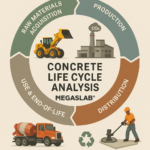Commercial property owners often face several issues with traditional concrete flooring. It’s not uncommon to deal with high maintenance costs, environmental concerns due to high carbon emissions, and a lack of energy efficiency. Additionally, traditional concrete may not always offer the best in terms of design versatility or long-term durability under heavy usage. These challenges can lead to increased operational costs and a negative impact on the environment. In response, low carbon concrete flooring emerges as a superior alternative, offering a multitude of benefits that not only resolve these challenges but also add value to the commercial property.
Here are 20 key advantages of using low-carbon concrete flooring in commercial spaces:
Reduced Carbon Footprint
Traditional concrete, especially those varieties using ordinary Portland cement, is a major contributor to global carbon emissions. The cement industry, in its conventional form, is known for being carbon-intensive due to the chemical reactions involved in producing Portland cement. By contrast, concrete with a lower carbon footprint, which may include alternative materials like fly ash, blast furnace slag, or calcined clays, significantly reduces these emissions. This reduction is important for businesses looking to contribute to global climate change mitigation efforts and demonstrate environmental responsibility. By lowering their carbon footprint, commercial properties can play a crucial role in reducing global greenhouse gas emissions.
Enhanced Energy Efficiency
Concrete with a reduced carbon content often exhibits superior thermal properties compared to conventional concrete. This improved thermal efficiency is crucial for commercial buildings, as it leads to natural energy conservation. Better heat retention means a reduced reliance on heating and cooling systems, which not only lowers energy bills but also contributes to a more consistent and comfortable indoor environment. This is particularly beneficial in regions with extreme temperatures, where energy costs can be a significant concern for businesses.
Exceptional Durability
Durability is a critical factor in commercial settings, where flooring is subject to constant and heavy use. Concrete with a lower carbon footprint often demonstrates enhanced strength and resistance to wear and tear compared to traditional concrete. This increased durability means a longer lifespan for the flooring, reducing the need for frequent repairs or replacements. This longevity translates into cost savings, less disruption to business operations, and a more sustainable approach by reducing the need for new construction materials.
Long-Term Cost Savings
The initial investment in concrete with a reduced carbon content might be higher than traditional concrete, but the long-term financial benefits are significant. Its durability and energy efficiency lead to lower maintenance, repair, and utility costs over time. Additionally, the use of materials like fly ash or slag, often by-products of other industrial processes, can sometimes reduce the material costs. These savings make it a financially sound choice for businesses looking at the total cost of ownership over the lifespan of their property.
Sustainable Material Use
The production of concrete with a lower carbon footprint often involves the use of recycled or waste materials, which contributes to a more sustainable use of resources. This approach supports broader sustainability efforts by reducing waste and the demand for virgin raw materials. It also aligns with the growing trend in the construction industry towards environmental product declarations and a more circular economy, where the environmental impact of building materials is increasingly scrutinized.
Improved Indoor Air Quality
Traditional concrete can sometimes emit volatile organic compounds (VOCs), which are detrimental to indoor air quality. Concrete with a lower carbon footprint often has lower VOC emissions, contributing to a healthier indoor environment. This is particularly important in commercial spaces where air quality directly impacts the health and well-being of employees and customers. Improved air quality can also contribute to higher productivity and a more pleasant working environment.
Aesthetic Flexibility
Commercial spaces often require specific aesthetic appeal, and concrete with a reduced carbon content offers versatility in design. It can be tailored to various textures, colors, and finishes, allowing for customization that aligns with the desired ambiance of the space. This flexibility is a significant advantage for businesses that want to create a unique and appealing environment for their customers and employees.
Compliance with Environmental Standards
Utilizing concrete with a reduced carbon content can help commercial buildings meet stringent environmental standards and regulations. This is increasingly important in a world where ecological responsibility is highly valued. Compliance with standards such as LEED (Leadership in Energy and Environmental Design) or BREEAM (Building Research Establishment Environmental Assessment Method) can enhance a building’s marketability and appeal to environmentally conscious tenants or buyers. It also positions a business as a leader in sustainable practices, which can be beneficial for corporate branding and customer perception.
Increased Property Value
Buildings that incorporate sustainable materials like concrete with a lower carbon footprint often see an increase in their market value. This increase is due to several factors: reduced operational costs, appeal to environmentally conscious buyers, and often superior aesthetic and functional qualities. In a market where sustainability is increasingly valued, properties that demonstrate environmental responsibility and reduced operational costs are more attractive to potential buyers and tenants.
Enhanced Corporate Image
Opting for environmentally friendly construction materials like concrete with a reduced carbon content reflects a commitment to sustainability, which can significantly improve a company’s public image. In an era where consumers and stakeholders are increasingly environmentally conscious, this can be a key differentiator in the market. Demonstrating a commitment to reducing carbon emissions and using sustainable materials can enhance a company’s reputation, attract environmentally conscious customers, and even improve employee morale and attraction.
Resilience to Environmental Factors
Concrete with a lower carbon footprint is often more resilient against various environmental stressors, such as extreme weather conditions, moisture, and temperature fluctuations. This resilience ensures the longevity and integrity of commercial flooring, making it a reliable choice for a wide range of climates and conditions. In an era of increasing environmental challenges, including climate change and extreme weather events, this resilience becomes even more critical. It ensures that commercial properties remain safe, functional, and aesthetically pleasing despite environmental stressors.
Mitigation of Urban Heat Island Effect
In urban areas, the heat island effect, where built-up areas are significantly warmer than surrounding rural areas, can be problematic. Concrete with a lower carbon footprint can help reduce this effect. Its properties, such as reflectivity and thermal mass, can contribute to a cooler urban environment. This is particularly important in densely populated cities where the heat island
Lower Water Usage in Production
The production of concrete with a reduced carbon content typically requires less water than traditional concrete manufacturing processes. This is particularly important in areas where water conservation is a key environmental concern. By reducing water usage, this type of concrete contributes to more sustainable resource management. It aligns with the growing emphasis on the construction industry’s environmental impact, where water usage and conservation are becoming critical factors in assessing the sustainability of building materials.
Stable Indoor Temperature
Thanks to its thermal properties, concrete with a lower carbon footprint contributes to a stable and comfortable indoor temperature. This stability is beneficial in maintaining a consistent climate inside the building, which is essential for both employee comfort and the preservation of goods or materials sensitive to temperature fluctuations. In commercial settings, this can translate to improved working conditions, better preservation of products (especially important in warehouses or retail spaces), and overall energy efficiency.
Acoustic Benefits
Managing noise levels can be a significant challenge in commercial spaces. Concrete with a reduced carbon content offers improved acoustic properties, helping to dampen sound and create a quieter, more focused working environment. This is particularly advantageous in settings such as offices, libraries, or educational institutions, where noise reduction is essential. Improved acoustics can enhance concentration, reduce stress, and contribute to a more productive and pleasant environment.
Easier Achievement of Green Certifications
Buildings with eco-friendly concrete are more likely to qualify for green building certifications like LEED or BREEAM. These certifications are not only a testament to the building’s sustainability but also make the property more attractive to eco-conscious tenants or buyers. Achieving such certifications can be a significant advantage in the real estate market, as they often lead to higher rental rates, increased occupancy rates, and overall higher property values.
Potential for Carbon Sequestration
Innovations in concrete technology have led to materials that can actively capture and store carbon dioxide, further reducing the overall carbon footprint of a building. This feature is a significant step forward in making commercial buildings part of the solution to climate change. Carbon capture in concrete is a cutting-edge development that not only reduces the carbon impact of the material but also turns the building itself into a carbon sink, contributing positively to the environment.
Reduced Transportation Emissions
Using locally sourced materials in the production of eco-friendly concrete lessens the need for long-distance transportation of materials, thereby reducing associated carbon emissions. This also supports local economies and reduces the overall environmental impact associated with material transport. By promoting local availability and use of construction materials, businesses can contribute to a more sustainable construction industry and reduce their carbon footprint.
Support for Local Economies
Choosing eco-friendly concrete supports local industries and economies, especially when these materials are sourced locally. This not only helps in building community resilience but also ensures that the economic benefits of construction projects are felt closer to home. It fosters a sense of community and sustainability, as local businesses and suppliers are involved in the construction process, benefiting from the economic activity generated by these projects.
Flexibility in Maintenance and Upgrades
Eco-friendly concrete is typically easier to repair and modify compared to traditional concrete. This flexibility is crucial in commercial settings where changes in layout or design might be necessary, and where minimizing downtime for maintenance or upgrades is important for business continuity. The ability to easily modify and repair flooring without significant disruption is a valuable attribute in dynamic commercial environments where adaptability and minimal operational interruption are key.
Why Low Carbon Concrete is a Superior Choice?
Low carbon concrete not only addresses the environmental and economic challenges posed by traditional concrete but also adds value to commercial properties. Its versatility, combined with environmental and health benefits, makes it an ideal choice for businesses aiming to reduce their environmental impact and operational costs. Investing in low carbon concrete is not just good for the business; it’s also beneficial for the people who use these commercial spaces, contributing to a healthier, more sustainable environment.
By choosing low carbon concrete, commercial property owners can enjoy a high-quality, durable, and environmentally responsible flooring solution that meets the demands of modern commercial spaces.
If you’re interested in reaping these substantial benefits and enhancing your commercial space with a responsible, sustainable choice, explore the possibilities of low-carbon concrete today. Check out MEGASLAB’S innovative eco-friendly concrete flooring slabs and start transforming your commercial space into an environmentally responsible and high-value property.




